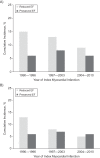Contemporary trends in heart failure with reduced and preserved ejection fraction after myocardial infarction: a community study
- PMID: 23997209
- PMCID: PMC3792728
- DOI: 10.1093/aje/kwt109
Contemporary trends in heart failure with reduced and preserved ejection fraction after myocardial infarction: a community study
Abstract
Major changes have recently occurred in the epidemiology of myocardial infarction (MI) that could possibly affect outcomes such as heart failure (HF). Data describing trends in HF after MI are scarce and conflicting and do not distinguish between preserved and reduced ejection fraction (EF). We evaluated temporal trends in HF after MI. All residents of Olmsted County, Minnesota (n = 2,596) who had a first-ever MI diagnosed in 1990-2010 and no prior HF were followed-up through 2012. Framingham Heart Study criteria were used to define HF, which was further classified according to EF. Both early-onset (0-7 days after MI) and late-onset (8 days to 5 years after MI) HF were examined. Changes in patient presentation were noted, including fewer ST-segment-elevation MIs, lower Killip class, and more comorbid conditions. Over the 5-year follow-up period, 715 patients developed HF, 475 of whom developed it during the first week. The age- and sex-adjusted risk declined from 1990-1996 to 2004-2010, with hazard ratios of 0.67 (95% confidence interval (CI): 0.54, 0.85) for early-onset HF and 0.63 (95% CI: 0.45, 0.86) for late-onset HF. Further adjustment for patient and MI characteristics yielded hazard ratios of 0.86 (95% CI: 0.66, 1.11) and 0.63 (95% CI: 0.45, 0.88) for early- and late-onset HF, respectively. Declines in early-onset and late-onset HF were observed for HF with reduced EF (<50%) but not for HF with preserved EF, indicating a change in the case mix of HF after MI that requires new prevention strategies.
Keywords: cardiovascular diseases; community studies; ejection fraction; heart failure; myocardial infarction; population-based studies; secular trends; surveillance.
Figures


References
-
- Gheorghiade M, Bonow RO. Chronic heart failure in the United States: a manifestation of coronary artery disease. Circulation. 1998;97(3):282–289. - PubMed
-
- He J, Ogden LG, Bazzano LA, et al. Risk factors for congestive heart failure in US men and women: NHANES I epidemiologic follow-up study. Arch Intern Med. 2001;161(7):996–1002. - PubMed
-
- Ezekowitz JA, Kaul P, Bakal JA, et al. Declining in-hospital mortality and increasing heart failure incidence in elderly patients with first myocardial infarction. J Am Coll Cardiol. 2009;53(1):13–20. - PubMed
Publication types
MeSH terms
Grants and funding
LinkOut - more resources
Full Text Sources
Other Literature Sources
Medical
Research Materials
Miscellaneous

